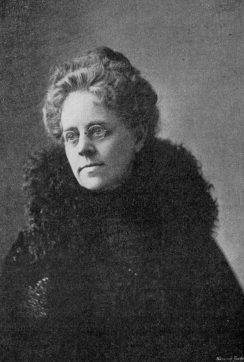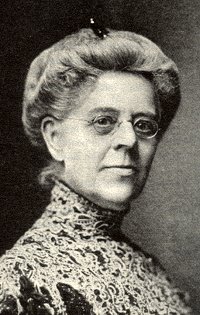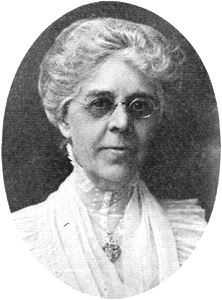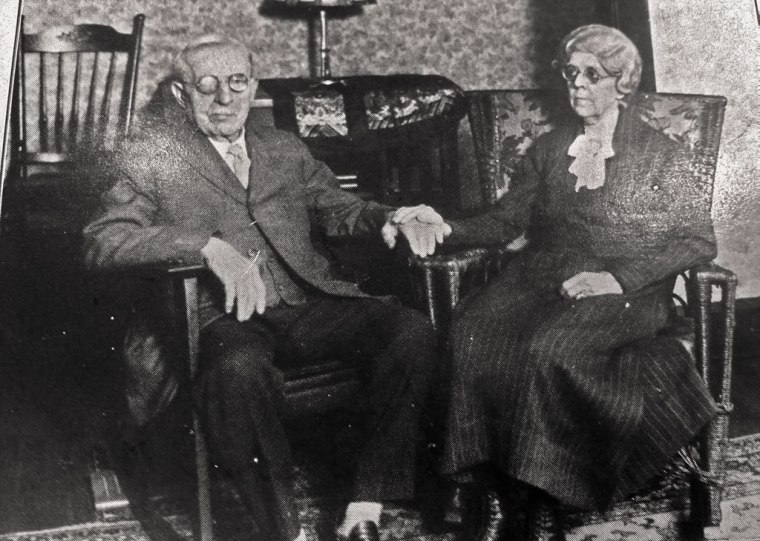
Emma Louise [Hindle] Ashford was born on March 27, 1850 in Newark, Delaware to Elizabeth [Pickcasgill] and James Hindle. Both parents immigrated from England. Her family moved frequently. Her father James was a singing teacher and farm laborer. Her mother possessed a beautiful soprano voice. She was brought up in a musical atmosphere and her talents quickly developed. Emma could sing from childhood, even before she could speak plainly. At eight, she was singing alto in her Episcopal Church choir, and was acknowledged to be the best sight reader in it. When she was ten years old a guitar was presented to her, with which within a few weeks she could play the accompaniments to the songs she sang. By this time she was a good performer on the piano and organ. By the age of twelve, she was organist at St. John’s Episcopal Church in Kewanee, Illinois. When fourteen years of age, she moved with her parents to Ballard Vale/Plymouth, Massachusetts. Here her guitar playing created quite an interest; and she taught a class of young ladies, and also sang in a choir. She was mentored by composer James R. Murray.
The family moved two years later to Seymour, Connecticut, and Emma was engaged as organist at St. Peter’s Episcopal Church. This was her first experience in playing the pipe organ, and after a year’s service resigned to take a larger organ at an advanced salary. While in Seymour she studied the piano with Mrs. Street, and the pipe organ with Dr. Anderson of St. Paul’s Church. It was later at one of the musical events in Connecticut where she met John Ashford, a native of Bath, England, and a young Mechanical Engineer and accomplished amateur Tenor. Captivated by Emma’s musical genius, John encouraged and inspired her musical development and work.
On December 24, 1867, John Ashford married Emma Louise Hindle in St. Charles, Missouri. Initially, they moved to Chicago, and while there, Emma held the position of Alto in the solo quartet under the direction of Organist, Choirmaster, and composer, Professor Dudley Buck, at St. James Episcopal Church. He offered Emma the Alto part over twenty-seven other applicants. Emma considered the year she spent under the guidance of Professor Buck to be her most significant and influential for her musical development.
Not long after their marriage, they settled in Nashville, as John secured a faculty position in Vanderbilt University’s Engineering department. There they remained, living at their house on the Vanderbilt campus, and in their last years in a new home near the campus, at 2105 Dixie Place. John Ashford was connected with Vanderbilt University for 42 years. He also held the position of Superintendent of Grounds for Vanderbilt University. He submitted his resignation to the Board of Trustees at age 82, apparently much to their regret.
Never leaving his own passion for music behind, John was active as a choral director and singer. He was organizer and first director of the Vanderbilt Glee Club. Emma was also well regarded at Vanderbilt, having contributed a significant number of musical compositions honoring the university, and for its Glee Club. Dean Herbert Tolman said of her: “Of the women of our city, some have distinguished themselves in literature and some in art, but in the realm of musical composition, there is one name that stands pre-eminent. It is the name of Mrs. Emma L. Ashford.”

In 1900 the Vanderbilt University celebrated its twenty-fifth anniversary. For this occasion Mrs. Ashford was asked to compose an Ode whose words were written by Olin Dantzler Wannamaker. The performance of the Ode was rendered by a chorus of eighty voices and an orchestra of twenty-five performers. After another memorable performance of the Ode in 1926, Chancellor James Kirkland complimented Mrs. Ashford publicly with the following remarks: “As long as men love the beautiful in music, so long will your name live and be cherished by Vanderbilt men and women.”
John and Emma worked together leading choirs of several of the largest churches in Nashville. Their relationship was characterized as “an inspiring musical companionship.” For ten years they had charge of the music in the First Cumberland Presbyterian Church and the Jewish Temple Ohabai Sholom simultaneously. She was well-known as a consummate organist. For several years she filled the place of organist at various churches, including the First Baptist, Tulip Street (Methodist), and Christ Church (Episcopal). For twenty years, Emma taught piano, organ, and harmony. Her health giving way and the increasing work of composition and editing compelled her to give up all organ and choir work, and eventually teaching, much to the regret of her friends and admirers. On all accounts, Emma was described as being a petite and somewhat frail person.
John fully supported and encouraged his wife to develop musically. Emma studied advanced harmony, counterpoint, canon and fugue, with Henri Weber and Dr. R. H. Peters, Mus.D. Dr. Peters held Emma in high regard, having this to say about her: “It was my pleasure to become associated with Mrs. Ashford several years ago in the capacity of instructor of the theoretical side of music. The first lesson she presented to me revealed the fact that here was a student quite beyond the average, a student with clear and deep insight into things musical, who was calculated to make good use of all knowledge acquired; while to her instructor she was not only a pleasure to teach, but soon became a positive source of inspiration. In the course of time Mrs. Ashford studied harmony, counterpoint (simple and double), canon, and fugue most successfully. Her work was excellent in every respect, and showed unmistakably that behind it all there existed brains as well as intense musical temperament and appreciation. For Mrs. Ashford’s ability in matters musical I entertain a respect that borders on the profound.”
As to Emma the person, here is how those her knew her best characterized her: “She is widely acquainted with literature and philosophy. A brilliant conversationalist, full of spontaneous wit, tactful, and cheerily kind, she is a welcome guest everywhere; and the coterie who frequently gather about her hospitable board or in her sunny music room are most proud to claim as friend and comrade this unassuming little woman who now has an international reputation in her chosen line of work.”
Emma made three trips abroad, in 1894, 1897, and in 1904, studying in England with the leading masters of the era. During the 1894 trip, she devoted the greater part of her time studying the higher forms of ecclesiastical music. She heard the best music offered in London, Paris, and other European cities to which her travels led her. On one of these occasions, Emma was offered a place on the programme of the National Convention of Music Teachers, held in Manchester, England. She regrettably declined because it occurred after the date fixed for sailing to America. In 1904, Emma returned on the White Star Line’s S.S. Cretic, leaving Liverpool on September 8, 1904 and arriving in Boston September 16.
In the later years of her life, her time was taken up entirely by composition. Emma first began publishing her compositions with the John Church Company, of which her work were mainly songs, quartets, and trios. Her best-known work of this period is her popular sacred song, “Abide With Me.” Later she began writing for E. O. Excell, where her most significant body of work was seventeen anthems which she contributed to that company’s Book of Anthems. She won numerous composition contests.
At around 1894, Emma began writing for E. S. Lorenz & Company, having won an anthem contest which the company conducted. Mr. Lorenz encouraged her to write more, suggesting that she write her first sacred cantata: “The Prince of Peace.” Also at this time, Emma became Editor of “The Organist,” and Associate Editor of “The Choir Leader” – both journals belonging to Lorenz. By 1897 she became Chief Editor of both journals. The professional relationship blossomed, and Emma spoke highly of her appreciation of the unvarying kindness and encouragement which Lorenz gave her in her musical work.
Emma became well known as a composer in Great Britain, and her fame spread as far as Japan, China, and India. Emma wrote between 600 to 700 compositions. She wrote several hundred anthems, sacred and secular cantatas, songs and duets, graded pieces for the piano, and song cycles. Seven Christmas Cantatas. Among the collections:
- Ashford’s Hymn Voluntaries, Volumes 1 & 2
- Vox Celeste, Volumes 1, 2 & 3
- The Pedal Organ, Volumes 1 & 2
- Favorite Organ Voluntaries, Volumes 1, 2 & 3
- Organ Praise Series
- The Diapason
- The Organist’s Helper
- The American Organist: Sacred Voluntaries, Volumes 1 & 2
- Ashford’s Organ Voluntaries, Volumes 1 & 2
- Ashford’s Easy Organ Voluntaries for Reed or Pipe Organ

Throughout her life, Mrs. Ashford’s character was known for wit, humor, and kindliness. At the same time, she gave serious consideration to the value of a well-rounded education and mentorship in music, with the genuine support of parents or guardians. She emphasized how critical it was, especially for young women, to be taught and mentored through a solid foundational series of music theory and part-writing courses.
Even though her focus changed to composition, she often continued to write advice and coaching articles and editorials on a multitude of musical subjects and notable people, with many based on the requests and questions from a delighted public.
On December 24, 1927, John and Emma celebrated their 60th wedding anniversary. By that time, Emma was a preeminent, world-renown composer. The local newspaper, on the occasion of their anniversary wrote: “The occasion centers the interest not only of their many personal friends in Nashville, but throughout the entire country, where Mrs. Ashford’s musical compositions are widely known.”

Emma Louise Ashford passed away on September 22, 1930, at age 80, in her home. She was survived by her husband John, who passed away a month later, at age 93. Emma was also survived by her son, Henry Stephen Ashford, her daughter-in-law, Gertrude Fleenor Ashford, her grandson, John Winthrop Ashford, and her granddaughters Louise Winthrop Ashford, Marjorie F. Ashford, and Lois Louise Ashford.
Emma Louise Ashford said that the thing which touched her most, which gave her strength and inspiration to labor, was the loyalty of her musical friends.
Today few musicians know about E.L. Ashford’s many compo-sitions for organ, and choirs. Most of her works published by Lorenz, were for the Lorenz, magazines which were designed for people who worked to find materials for worship in small churches all over the world, people who needed something they could successfully present despite limited education, skills, knowledge, preparation time, limited instruments. material to fit the calendar, the liturgical season.